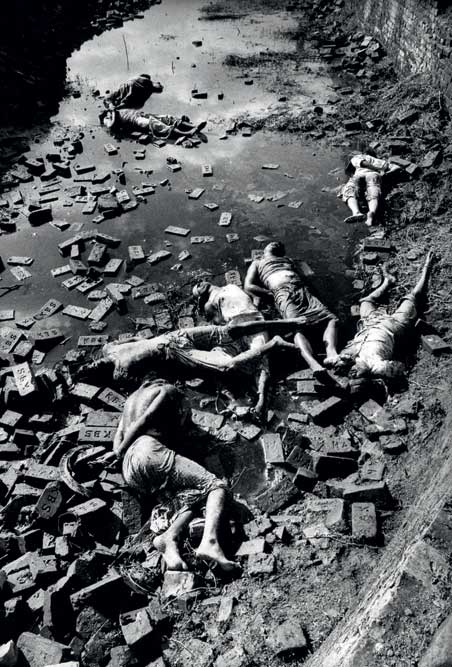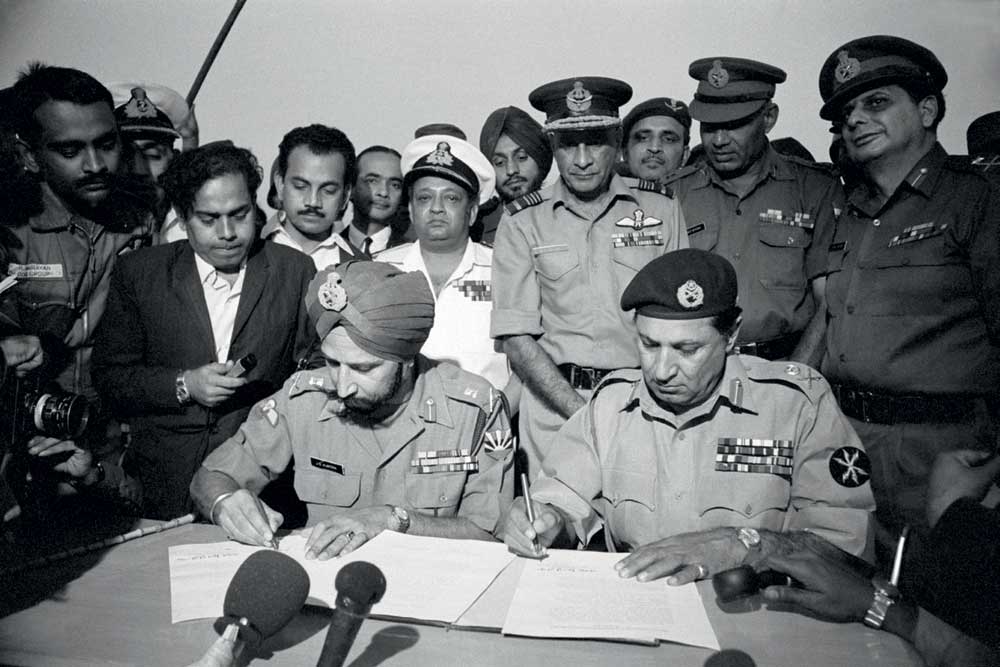The Architecture of Atonement
What Germany could teach Pakistan about admitting genocide
 TCA Raghavan
TCA Raghavan
 TCA Raghavan
TCA Raghavan
 |
23 Dec, 2022
|
23 Dec, 2022
/wp-content/uploads/2022/12/Architecture1.jpg)
The Memorial to the Murdered Jews of Europe in Berlin (Photo: Getty Images)
PAKISTAN’S LATEST ‘GAME of Thrones’ attracted much attention over the course of this year: its political class battled it out with each other and with the army in full public gaze and with greater public scrutiny than perhaps ever before. In this scrum another contentious if largely historical note was introduced by the outgoing Chief of Army Staff General Qamar Javed Bajwa when he spoke about the events of 1971 in East Pakistan—in effect saying that misinformation has surrounded events of the time to the cost of the military’s reputation. The headline that emerged was his principal contention: the breakup of Pakistan was on account of political rather than military agency. His point was that 34,000 Pakistani combat troops faced a numerically superior Indian and Mukti Bahini combined force; and the bulk of the 94,000 Pakistanis who surrendered were non-combatants.
The events of 1971 are usually referred to in Pakistan as a tragedy; the term most commonly used in Urdu to describe them is “Saneha”. For most, the term fits because each of the principal actors acted in ways that expedited the final tragic outcome. Most would agree that virtually all of West Pakistan’s political class, with Zulfikar Ali Bhutto at the head of the list, were also culpable. The general view is that the leading protagonist in the headlong charge into disaster was the higher command of the Pakistan army. For West Pakistan to think of a successful military operation in its eastern wing was akin to the Pakistani army conducting campaigns in Europe. That was the geography involved and made even more difficult by the fact that what lay in between was the vast territory of a hostile India. Not to have factored this in was colossal military misjudgement at the very least; a political and strategic blunder, no less. The force levels were not therefore relevant although the figures cited by General Bajwa are in any case misleading. But all this is of course quite apart from the other blunder of the Pakistan military in East Pakistan: blackening its name with genocide and rape on a vast scale.
In Pakistan, the debate of civil versus military responsibility is not a new one. However, it usually surfaces only in December each year coinciding with the fall of Dacca and the surrender of the Pakistani military formations located in East Pakistan. That the outgoing chief made his remarks last month converted this somewhat ritualistic December discussion into a November debate. His speech had been to an audience made up largely of ex-servicemen and their families—the die-hard army constituency in Pakistan and to which the general’s logic in ascribing responsibility for the breakup of Pakistan would appear unexceptionable. But there were probably other reasons for his choosing to make these remarks at that point of time: the immediate months past had seen possibly some of the most intense discussions ever in Pakistan on the role of the army in politics. How Sheikh Mujibur Rahman became a rebel and finally the head of a secessionist movement largely because of how the Pakistani army treated him was a memory frequently invoked by Imran Khan. In itself the expression of such views was seen as Imran’s protest because the military had demolished the hybrid regime he had headed and one that they themselves had created in the first place. Yet Mujibur Rahman had also been invoked from the other end of the political spectrum by former Prime Minister Nawaz Sharif after he, too, had been forced out of office. Clearly both these sets of critiques—from different directions but similar in character—had weighed on General Bajwa when he sought to exculpate the Pakistan army for its role in 1971.
It would, however, be too easy to see his speech as yet another crude attempt to manipulate the historical record. While the contemporary debate in Pakistan over the army and its role in politics is intense and lively, the East Pakistan analogy is more in the nature of clinching an argument rather than an introspection of what happened in East Pakistan in 1970-71. The general view that existed in the immediate aftermath of the breakup in 1971 has continued and perhaps even consolidated: that Pakistan was more victim than accused; and inadvertently trapped in a larger geopolitical tangle in which it was no more than a pawn. Culpability lay with a venal leadership with low moral character and here a consensus has developed around the figure of General Yahya Khan: his drinking, womanising and general absence of focus all make him an unexceptionable target. Or General AAK Niazi who surrendered without a fight in Dacca. But the line is generally drawn after acknowledging the debauchery and cowardice of a selected few. The larger issue of massive human rights violations and genocide, and of the large element of complicity of the West Pakistan political class with the action taken by the military, is generally left unaddressed and unacknowledged. The view remains that a victor’s narrative has prevailed—in particular that spun by India and by Bangladesh as it emerged.
II
Such historical amnesia and denial are seen generally in conjunction with Pakistan’s stunted political development and in particular the role of its army in the political life of the country. This is not an invalid inference. Nevertheless, national amnesias and denials are not limited to political ecosystems which have not evolved and changed. We encounter these frequently elsewhere and even in those situations where breaks with the past have otherwise been deep and radical.
Germany is usually cited as the contrarian example to national amnesia. Here, it can be said without too much equivocation, is the example of a country consciously and profoundly acknowledging and facing up to all the dark recesses of its past. Even a casual visitor to Berlin today is confronted by this facing up to the reality of what Germans did to Jews, Slavs and other selected minorities in the 1930s and 1940s. Berlin is dotted with these sites of memory—the Jewish Museum and the Holocaust memorial amongst numerous other memorials of remembrance to murdered Jews, Gypsies and others, the locations of former synagogues, even markers in otherwise not very important streets and lanes indicating names of individuals and families who were picked up to be killed.
Seeing this profound atonement for the past today makes it difficult to recall how gradual and even tentative the process was after the war. Most Germans saw themselves as victims of Allied bombings, of the rape and pillage of the Soviet army as it advanced into Germany in 1945, and of the ethnic cleansing of millions of Germans from Eastern Europe. Many also saw themselves, or convinced themselves, that they were victims also of Hitler and the Nazis; in other words, they were now being made to pay for someone else’s crimes. Given the mass support Adolf Hitler and the National Socialists had mobilised this was a selective recollection of German history but it was nevertheless a deeply internalised one. Most former Nazis were quietly rehabilitated and the traumas of the post-war period made the period 1933-45 slip into the background.

But gradually there was a change in attitudes, perhaps especially so in the Federal Republic of Germany, or the erstwhile West Germany. While the idea of shared guilt was perhaps never fully accepted, there was nevertheless an open and genuine acknowledgement of Germany’s dark recent history. This process, historians have shown, however, really gathered traction only from the 1960s as a new post-war generation of Germans simultaneously confronted both their parents and their history. German atonement was sincere and real; from reparations paid to Israel and compensation to other European countries. Most of all, there was an acknowledgement in domestic discourses of the basic principle which Chancellor Willy Brandt articulated: “No German is Free of History”. The German term Vergangenheitsbewältigung, loosely translated as “working of the past”, summarises this approach and what it had meant was accepting and internalising the fact that Germans were responsible for causing grievous harm to others and then integrating this view into public policy.
History never has finality and even in Germany there are contrarian developments. Vergangenheitsbewältigung was a phenomenon in West Germany; the German Democratic Republic, the former East Germany, did not see itself as a successor state to undivided Germany and therefore did not feel morally responsible for the crimes of the Nazis. There are also substantial critiques that in West Germany itself the apologies often offered by former Nazis were proforma and superficial and that the process of de-Nazification and atonement was more tactical than conceded. A unified Germany has also not been immune to the rise of rightwing extremism and of racial and ethnic hatred. How these have emerged and sustain themselves is much discussed and it is undeniable that there is a discernible Nazi revisionism that exists on the margins of the extreme right. The view that the “culture of atonement” that exists in Germany is false, in terms of being unnecessary, may not be a significant minority view but it is certainly stronger today than a decade or two earlier.
Atonement as national policy has remained a hallmark of Germany. It has become a template for other situations of major humanitarian crimes. Situations where the German template can be cited vary widely: Bangladesh of course, Turkey vis-à-vis Armenians; Myanmar and Rohingyas, and many others
Yet, all such caveats notwithstanding, atonement as national policy has remained a hallmark of German domestic and external policy. It has become in the process a kind of model or template of measurement for other situations of major humanitarian crimes in which there are clearly identified victims and perpetrators, especially in transnational contexts. Situations where the German template can be, or is, cited vary widely: Bangladesh of course, Turkey vis-à-vis the Armenians; Myanmar and the Rohingyas, and many others. Demands for reparations for genocide in colonial and quasi-colonial conditions have been made of former European colonial powers—in particular Belgium, France, Britain, the Netherlands, etc.
III
However imperfectly, the German model created an ‘ideal type’ or model template of national and transnational reconciliation. Its basis derived from a shared reading of the history of the 1930s and 1940s. This shared reading and the acknowledgement that genocidal actions had taken place enabled the construction of an architecture of atonement which facilitated reconciliation with both Israel and elsewhere in Europe. Contrarian perspectives, such as those of Holocaust deniers, have remained, but on the whole are marginal to this mainstream narrative.
Shared histories are, however, rare. A more complicated picture of colonial exploitation, gross human rights violations amidst divergent historical narratives underwrites the South Korea-Japan relationship. Its colonisation of Korea from 1910 was to most Japanese an affirmation that they were also a front-ranking nation: having a colonial empire, in emulation of contemporary European powers, was a necessary condition and adjunct of that status. Acquiring colonies, and the Korean peninsula was an obvious enough candidate, was the means to consolidate the newfound status it had acquired after defeating Russia in the Russo-Japanese war of 1904-05. Japan was thus the first Asian power to have arrived—or so most Japanese felt.
Imperial Japan’s tryst with greatness ended with its defeat in the Pacific war. In many ways its record in Korea during 1911-45 rivals the worst aspects of European colonialism in Africa and in Asia. Yet, as is often the case, colonisation of Korea also unleashed modernising impulses in industry, in education, and in other fields.
But what is striking is how, with the passage of time, the Korea-Japan interface has not eased but become even more intensely friction-ridden. Often, the passage of time does not by itself act as a healer but historical memory acts conversely to magnify an inherited sense of injustice and wrong.
In the Japanese perspective, numerous attempts have been made to address this sense of wrong at their hands, including by apologies and sentiments of regret expressed at the highest levels, by offering what amounts to generous volumes of funds as compensation. Yet none of this has ever been enough to satisfy public opinion in Korea. Such sentiments of regret are seen as insincere and inadequate. The Korean suspicion of an absence of true atonement is strengthened by a rising trend in Japanese politics which can be summarised as an exhaustion with the culture of apology and an assertion of Japanese nationalism.
A flare-up of these accumulated tensions became evident in 2018 when South Korean courts ruled that Japanese firms that had used forced labour during the colonial period should pay compensation. When some firms did not comply, their assets were seized. Japan retaliated first by a public boycott of Korean goods and then by withdrawal of Korea’s Most Favoured Nation (MFN) status, otherwise the basis on which normal trading relations are conducted at the international level today. South Korea in turn retaliated by withdrawing from an intelligence-sharing agreement. Many observers were baffled. Both were strong allies of the US, with converging interests on issues confronting East Asia. They had moreover worked at reconciliation since 1965 when diplomatic relations were established and Japan made significant investments and gave loans to facilitate the normalisation of relations.
Notwithstanding phases of normalisation, the relationship had many fronts on which history wars periodically erupted. These ranged from Japanese school textbooks and disputed islands to ministerial visits to the controversial Yasukuni shrine. Historical revisionism has steadily strengthened in Japan: the excessively negative portrayal of Japanese actions in World War II; that Japan’s wars were actually defensive; and that its actions were directed at ending European colonialism and instilling an idea of Asian unity and self-confidence. Each of these is an emotive and sensitive point for many in Asia—for the Chinese, the Taiwanese, the Filipinos, but perhaps most of all for the Koreans.
The most sensitive issue has been of “comfort women”—forced into sex slavery and prostitution for the Japanese army. For the South Koreans, Japanese contrition and admission of the crime is insufficient, even insincere. For the Japanese, it is the constant reopening of issues long settled and generously compensated.
IV
In the US during the Trump presidency, the debate on the economic and social legacy of slavery often got focused on statues of Civil War personages who had been leading protagonists and leaders of the Confederate States—the southern states fighting for secession and the right to remain slave societies. In the UK, too, such statue wars have occasionally surfaced, with demands to remove those associated with the slave trade or, more infrequently, with particularly heinous colonial crimes. However, the demands to remove such statues in Europe are not as intense as those in the US.
But a statue war of sorts had erupted in the South Korea-Japan interface in 2011 and, in fact, anticipated the statue wars elsewhere, although the process involved not the removal but the erection of statues to animate memories of a traumatic historical process.

In 2011, an association of women protesting against sex slavery and prostitution practised by the Japanese in Korea unveiled a statue depicting a comfort woman outside the Japanese Embassy in Seoul. The move was soon being replicated in public places or outside Japanese offices. An agreement in 2015 largely failed to address respective concerns and led to the removal of the statues. The two sides have drawn opposite conclusions from this: for the South Koreans, an absence of real atonement on Japan’s part; for the Japanese, the inability of the Korean government to implement any agreement on this issue.
What underwrites the issue in both countries are conflicted narratives to explain the past and how these narratives have strengthened rather than weakened over time. Time, therefore, is not necessarily a great healer but can make old wounds appear even more egregious.
When contemporary geopolitics enters the equations of the politics of history and of memory, the battlelines are even more firmly drawn. The current conflict in Ukraine provides a graphic illustration. Arising out of contemporary geopolitics it is nevertheless cast by both sides in historical terms. For the Russians, the adversaries are the crypto Nazis of Ukraine now backed by the US and the West. For the Ukrainians, the conflict is only a replay of a much older script of Absolutism vs Democracy. Russian President Vladimir Putin’s antecedents are thus found in Stalin and Russian behaviour today is traced back to the Soviet terror of the 1930s. In this play of narratives, a famine that swept across large parts of the former Soviet Union in 1932-33, with a particular intensity in Ukraine, is also a battleground.
The line is generally drawn after acknowledging the debauchery and cowardice of a selected few. The larger issue of massive human rights violations and genocide is generally left unaddressed and unacknowledged
For many in Ukraine the “Holodomor” famine was a genocide perpetrated by the Soviet leadership on the people of Ukraine as a deliberate act of repression and punishment. About four million died, over 10 per cent of the population of Ukraine then. This was the result of the forced collectivisation ordered by Stalin; but was it genocide? The Russians say no—even if there is some acknowledgement of the famine and the death toll as the outcome of disastrous policies; but they emphasise that the famine was not specific to Ukraine and affected other parts of the Soviet Union as well.
The Holodomor has been a contributing factor in the crystallisation of Ukrainian identity since the breakup of the Soviet Union. As its conflict with Russia has matured over the past decade, recognising it as genocide becomes part of the arsenal in the wider geopolitical tangle between Russia and the West. The latest on the list of countries to view the Holodomor as deliberate genocide is Germany, with its parliament adopting a resolution to that effect. Politics, geopolitics, history, and memory come together again in a tangled web.
Are these random instances relevant for us in any way beyond the obvious that the weight of history spares none? Perhaps they may be a reminder that the recesses of our past, too, have spaces of shadow and light where atonement, amnesia and even denial jostle with each other. In any case, each of these contestations should cause little surprise to us in India, engrossed as we are in our own variants of history and memory wars. These rage through our ancient, medieval and modern pasts without too much discrimination. Should we be concerned? Perhaps a little since some of what is offered as historical revisionism is little more than crude political propaganda and distortion. Some of it is inspired entirely by communal passions which have more to do with contemporary politics rather than medieval injustices. Some debates and theories about our ancient past are more revealing about the confidence we are trying to induce in ourselves about a promised future. Yet, we need not worry too much—history-writing frequently has been a handmaiden of politics and there is no reason why it will stop now. As long as we remain conscious of any and every historian’s biases and predispositions, navigating through different claims and counterclaims is part of the excitement of reading and writing history.
Revisionism is as old as history itself and can be a welcome correction of received views that may have remained unquestioned for too long. Crude attempts to either rewrite the past or to whitewash or distort it will be rejected and exposed when the page is rewritten, as it inevitably will be. After all, the past is never uncontested. As William Faulkner said, the past is never dead, it’s not even past.
About The Author
MOst Popular
3

/wp-content/uploads/2025/07/Cover-Shubman-Gill-1.jpg)












More Columns
Nimisha Priya’s Fate Hangs In Balance, As Govt Admits It Can’t Do Much Open
Roots of the Raga Abhilasha Ojha
An Erotic Novel Spotlights Perimenopause Nandini Nair